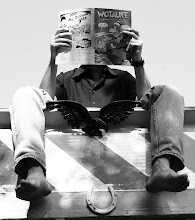
Somewhere in a world caught between the gelatin folds of my bluey-grey brain, there exists a comic book featuring Batman outfitted with a gun holster, a weapon he uses without pause on every criminal he catches, gunning them to pieces with a vengeance befitting his mad disguise.
This comic, born of a mind succumbing to the sweet poison of sleep, I would title SERVES THEM RIGHT.
It was most surely printed in 1941, two weeks before America entered the Second World War, the last time a pacifistic citizenry would claim shock at the action of the bullet, wetting their lips on the milk of the honey called Freedom – the carnival prize hung just out of reach by the wrinkled white faces lurking the midway.
As bizarre as it might seem for a character such as Batman to carry a gun, it is hardly a stretch – a pistol being, after all, a far more plausible weapon than the Looney Tune gadgets he carried around with him throughout the 50s and 60s. But Bob Kane’s dark knight, though he affected the tone of hard-boiled crime cartoons like Dick Tracy, was quickly swept into the legion of punching “long johns”, the mimics and imposters born in the wake of Superman’s speeding popularity, agents of justice who might out-race a bullet, or melt shut a gun barrel with their eyes, but would never utilize one – less they become as evil as the villains pitched against truth, justice and the American Way.
This, of course, was a load of rubbish, the stampeding way of America primarily being fueled by the advancement of weaponry manufacture, namely its pivotal part in the innovation of mass production, spurred on by the Springfield Armory during the American Civil War.
It was with the advent of WWII that America’s munitions industry truly went supernational, the first world conflagration in 1914 having been its proving ground.
After the attack on Pearl Harbor there was no turning back, America spent the next decade on an adventurous game of weaponry hopscotch, leading up to what Dwight D. Eisenhower cautiously dubbed “the military industrial complex“, the furious business model that torpedoed itself around the globe, forever changing the face of war, American weapons and armed bases having been a featured part of practically every national and international fisticuff since – be it covertly, or in blatant defiance of supposed international law.
Such an infusion of business opportunity, spurred on by tragic circumstance, is what 9/11 theorists latch onto in their illustration of a government complicit in its own injury, seeing the pre-WWII pacifism in direct correlation with the pre-9/11, post-Soviet Union, militaristic ambivalence that permeated American politics – George Herbert Bush’s saber-rattling in the Middle East having whet the appetite of those still lurking in the sticky shadows of the midway.
Such international operations – from Vietnam to Korea to Grenada to Panama to Iraq – have all been sold with the glorified image of the armed benefactor, the soldier, the officer, the angel of justice who has been part of America’s identity from the outset, flint arms and matchlocks carried to the new shores by the Puritan pilgrims in the late 1600s, weapons used to keep wild animals, and native peoples, in their place. Early settlements like Jamestown and Henricus had sheriffs (“shire-revee”, in Old English, from shire, as in county), men who oversaw the implementation of law, a system of governance more often than not enforced with the barrel of a gun.
The emblem of this system, its uniformed, armed herald of order, has been forged right along with the country’s identity – from Ethan Allen’s Green Mountain Boys to Marshall Matt Dillon in Gunsmoke, from Capt. James Tiberius Kirk wielding his phaser to the Governor of California sending shotgun shells careening across movie screens. Americans equate a civilized society with the security sitting within the cylinder of a gun – be it a weapon hanging from the belt of the badge-wearing grandfather paying for his coffee, the bored ex-football player standing mutely in the alcove of a shopping mall, or the Gulf War vet greeting you at the entrance to your local Target – irony filling his black leather holster.
Every boy grows up cradling an imaginary pistol in his hand, watching the olives and midnight blues flickering on the television screen, the bullets loaded behind enemy lines and patrol car alike, every police station housing the neighborhood army, those citizens entrusted with the deadly toys of their trade – an officer’s only friend when the chips are down.
The way in which the gun has defined America’s notion of security goes hand-in-hand with how the country has matured itself, leaving a Glock under Little Nemo’s pillow, a Colt beneath Linus’s blanket – a nation of grown-up children going POW! POW! POW! in the face of a reality indifferent to the trappings of justice, where every designation of who is to be protected, and who is to be served, carries with it a sentence of time – the speed of which travels an oiled barrel of steel.
No matter how noble the impulse, no matter how pure the intent, no matter how firm the nerves, how fair the heart – those who marshal the prescribed order are the Dynamic Duo of justice’s pulpy face, the weapon drawn quickly asserting its senior role in the duo – leaving a costumed boy wonder holding the trigger.






